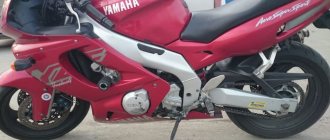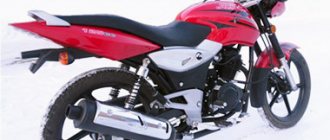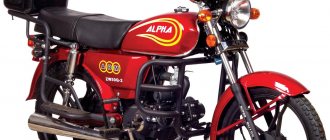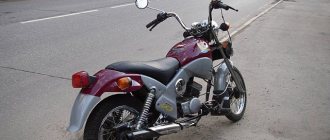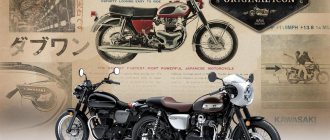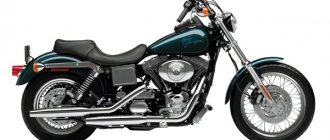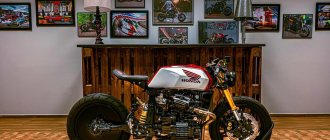JAWA 125 Dandy - a cheap normal motorcycle
The presentation of the Jawa Dandy 125 motorcycle took place in 1998.
This new product was presented to motorcycle enthusiasts by a popular Czech company, which still evokes in many motorcycle enthusiasts nostalgic memories of the good old days, when Java motorcycles were the standard of reliability and quality. However, today there is little more than just one legend left from this legendary brand. This “a little more” lies in the new models with which the company is trying to somehow gain a foothold in the global motor market. The recent finding on the verge of bankruptcy and the lack of funds to conduct a full-fledged marketing campaign (let alone the full development of the company and its model range) leave their mark on the products. At the same time, it is too early to write off the Jawa brand, especially since the new model range is of quite acceptable quality and is offered at prices affordable for a wide range of motorcycle enthusiasts. JAWA 125 Dandy motorcycles represent the embodiment of the best traditions of this family, although its appearance and design do not in any way remind us of the technology of the company's bygone days. Most likely, the motorcycle looks like a moped that weighs only a hundred kg. However, this is not at all a children's technique. The model is equipped with a single-cylinder, four-stroke, air-cooled engine that reaches speeds of up to 108 km/h. At the same time, the long suspension travel allows the motorcycle to be used outside of roads with improved surfaces. As an option, you can avoid traffic jams on the sidewalks, easily jumping onto the curb and sliding off it to the exclamations of indignant people.
The Jawa Dandy 125 motorcycle, which does not have a particularly flashy appearance, has good maneuverability due to its dimensions 2085x705x1055 and other technical parameters. Easily overcoming obstacles and the ability to enter narrow gaps makes its use simply irreplaceable in city traffic jams.
In addition to the 10-horsepower engine with 8200 rpm and its optimal dimensions, the motorcycle is also equipped with an excellent pendulum-type rear suspension with a monoshock absorber. And to stop such a high-spirited horse, the model is equipped with hydraulic disc brakes. All other equipment is standard for this type of model: a five-speed gearbox, an electric starter, a multi-disc clutch and a carburetor type of power supply.
Among the performance characteristics, it is necessary to highlight fuel consumption, which is 4-5 liters per 100 km. The disadvantage of the power system is the presence of a small tank with a capacity of only 6.5 liters, which makes it possible to move only 130-150 km without stopping. Although, with today's developed network of gas stations, it is very difficult to call this a disadvantage. Moreover, the motorcycle is not suitable for long trips on the highway.
Buying this Dandy from JAWA is very easy. This can be done in any online store or dealership of the company. The cost of a model without mileage will be about $3,500, which is quite a bit and makes the motorcycle affordable in our motor market. And on the secondary market such a motorcycle can be purchased at half the price. There are also no problems with components and spare parts for the motorcycle, and their prices are quite affordable.
Motorcycle appearance
Jawa dandy 125 at first glance may not seem like a full-fledged motorcycle, but rather a moped. The reason is that the bike is very compact and neat. If you consider that the Dandy is equipped with a 125 cc, 13 horsepower engine, you understand how successful this solution is in city driving conditions.
The front fairing of the motorcycle looks very attractive, made in a neat dynamic style. The guards, made in the style of sports bikes, also match it.
The exhaust pipe of the Jawa Dandy 125 is chrome plated, as are some other parts. Light-alloy cast wheels also add sporty charm to the motorcycle.
Jawa Dandy 125
For the first time, the Jawa Dandy 125 motorcycle, produced by the Czech company JAWA, was presented to motorcycle enthusiasts in 1998. Usually, when the phrase “Java motorcycle” is mentioned, old Soviet motorcyclists fall into nostalgic memories of those times when this bike was an object of desire for very, very many.
The history of the company itself began in 1929, when Frantisek Janecek, hitherto engaged in the arms business, acquired a license to manufacture the Wanderer motorcycle. By combining the first letters of the words “Janeček” and “Wanderer” the company name JAWA (Java) was born.
Since then, a lot of water has passed under the bridge and this company has had its ups and downs, but it is trying not only to survive in the current difficult economic situation, but also to develop, constantly improving its new models.
Java Dandy 125 motorcycle embodies the best traditions of quality, but in its appearance it is very far from the classic presentation of motorcycles from this company.
It is a lightweight motorcycle, weighing only 103 kg, more similar to a moped than a bike, however, it is equipped with a four-stroke, single-cylinder, air-cooled 125 cc engine, which allows it to accelerate to a speed of 108 km/h .
Not at all flashy in appearance, the Jawa Dandy 125 , thanks to its overall dimensions 2085x705x1055 and other technical characteristics, is very nimble and maneuverable. It allows you to squeeze into gaps that even some scooters cannot fit into, and easily overcomes obstacles in the form of curbs, which makes it simply irreplaceable in city traffic jams.
It’s not just the 10 hp engine that gives this motorcycle confidence on city roads. at 8200 rpm and its dimensions, but also a good pendulum rear suspension with a monoshock absorber. And hydraulic disc brakes provide perfect, fast, easily controlled braking.
The rest of the “filling” is classic for 125 cc motorcycles: a five-speed gearbox, multi-disc clutch, carburetor power supply, electric starter.
The fuel consumption of the Java Dandy 125 motorcycle is 4-5 liters per 100 km. One of the disadvantages is the presence of a 6.5 liter tank, which makes it possible to travel a distance of 130-150 km without refueling. But, with today's development of the gas station network, can this be considered a disadvantage?
Buy Jawa Dandy 125
Now buy a Java Dandy 125 motorcycle in many online stores and dealerships of the JAWA company. The price for this zero mileage model is approximately $3,500. However, thanks to such a service as the sale of used motorcycles, today it is possible to purchase a used bike for half the price. Finding the necessary spare parts for this model will not be difficult, and their prices are affordable.
Therefore, if you like leisurely riding and you have to ride a lot in city traffic jams, going around them, crossing tram tracks or curbs, then the Java Dandy 125 will be an ideal purchase for you. It will be an excellent choice for novice bikers, teenagers and even girls.
Technical characteristics of Jawa Dandy
| Engine's type: | four-stroke |
| Cooling type: | air |
| Number of cylinders: | 1 |
| Cylinder diameter: | 56,5 |
| Piston stroke: | 49,5 |
| Working volume: | 124 |
| Compression ratio: | 9 |
| Power, kW/h; rpm: | 9,4; 8200 |
| Ignition type: | kickstarter; electric starter (optional) |
| Gearbox type: | mechanical; five-speed |
| Wheelbase, mm: | 1330 |
| Saddle height, mm: | 830 |
| Gas tank volume: | 6.5 (+1.2 reserve) |
| Wheel type: | alloy wheels (light alloy) |
| Tires (front; rear): | 2.75 to 17; 3 to 17 |
| Front suspension type: | telescopic |
| Rear suspension type: | pendulum with monoshock absorber |
| Front Brake Type: | hydraulic; disk |
| Rear brake type: | hydraulic; disk |
| Motorcycle weight, kg: | 103 |
| Maximum speed, km/h: | 108 |
The average fuel consumption of the motorcycle is 4.5 liters per 100 kilometers, which is quite low compared to its technical characteristics. The undoubted advantage of the Java Dandy is cross-country ability . Thanks to the bike's balanced chassis, it copes well with road imperfections and tram tracks without losing control.
Java 125 Dandy reviews
Main characteristics
| Make: BMW | Gearbox: automatic / manual |
| Model: X1 | Body: sedan, coupe, station wagon |
| Year of issue: 2009 | Power: petrol/diesel |
| Engine capacity: 1985 cm³ | Drive: rear |
–>
- Safety
- Reliability
- Appearance
- Dynamics
- Comfort
- Economical
Average rating 2.8
Specifications
- Brand: Jawa
- Model: 125 Dandy
- Other name: 125 Dandy
- Years of production: since 1998
- Type: road
- Engine capacity: 124 cm³
- Maximum power: 12.8 hp
- Transmission: 5-speed manual
- Seat height: 830 mm
- Curb weight: 103 kg
Review of Jawa 125 Dandy
The small-capacity road motorcycle Jawa 125 Dandy debuted in 1998 and is still in production. Outwardly, it looks like a moped and does not in any way resemble its famous predecessor. It is based on a 1-cylinder, 4-stroke, air-cooled carburetor engine. Its volume is 124 cc, power is 12.8 hp, torque is 9.2 Nm, which is achieved at 7000 rpm. It works with a 5-speed gearbox and multi-disc clutch, and the maximum speed is 108 km/h. Average fuel consumption is 4-5 l/100 km.
One of its features is a long-travel suspension, which allows you to move through rural areas and overcome curbs without problems. The travel of the telescopic fork is 170 mm, the pendulum monoshock absorber is 150 mm. Hydraulic brakes, 1 disc per wheel. The front tire is 2.75x17, the rear is 3x17.
Main competitors: Minsk C4 125, Stels Trigger 125, Yamaha YBR125
Length: 2085 mm Width: 705 mm Height: 1055 mm Wheelbase: 1330 mm Tank: 6.5 l
Owner reviews about Java 125 Dendi
Jawa 125 Dandy
Jawa 125 Dandy – photo 1
Jawa 125 Dandy – photo 2
Jawa 125 Dandy – photo 3
Jawa 125 Dandy – photo 4
Jawa 125 Dandy – photo 5
Technical characteristics of Jawa 125 Dandy
| Year of issue | 2005 |
| Type | Motorbike |
| Class | Motorcycle road |
| Length, mm | 2085 |
| Width, mm | 705 |
| Height, mm | 1055 |
| Seat height, mm | 830 |
| Country of assembly | Czech |
Modifications of Jawa 125 Dandy
Jawa 125 Dandy 12.8 hp
| Maximum speed, km/h | 108 |
| Acceleration time to 100 km/h, sec | – |
| Engine | Gasoline carburetor |
| Number of cylinders / arrangement | 1 |
| Number of bars | 4 |
| Working volume, cm 3 | 124 |
| Power, hp / rpm | 12.8/8200 |
| Torque, N m / rpm | 9.2/7000 |
| Fuel consumption, l per 100 km | 4.0 |
| Curb weight, kg | 103 |
| Gearbox type | Mechanical |
| Cooling system | Air |
| Show all characteristics | |
Odnoklassniki Jawa 125 Dandy price
Unfortunately, this model has no classmates.
Reviews from Jawa 125 Dandy owners
Jawa 125 Dandy, 2005
I am the happy owner of an interesting motorcycle – Jawa 125 Dandy. My motorcycle life began with a Karpaty-2 moped, which a friend gave me last year for 500 rubles; he simply didn’t need the moped. They started it that same evening (it had been sitting in the barn for about 5 years, the owner claimed that it would not start), and crashed it the next day - I managed not to react and at full throttle caught up with the same moped (we only have 2 of them at our dachas) , a friend was sitting on a moped. Not a scratch on us, but mopeds are almost finished. They took it to the garage, painted it, invested 4 thousand in spare parts and sold it for 9 thousand. After the sale, I began to look for decent equipment, at first I wanted a Java 350, but when I looked at the characteristics, I realized that I couldn’t lift it off the stand (I’m 14 years old) . And then I came across an excellent example - Jawa 125 Dandy with a mileage of only 3600 km. It was made in 1998 and was sold new in 2006 (strange fate, but the date of purchase in the title confirmed the owner’s words). They asked 30,000 for it due to an urgent sale, I decided to take it, even though it was expensive. The owner gave the mirrors separately from the motorcycle, they were not original and did not fit into the holes intended for them - then he drilled them out. The motorcycle needed a lot of repairs - the previous owner didn’t particularly care about the condition, which is why he sold it so cheaply (the price of a new motorcycle is 125,000 rubles). But it was all small things - I invested about 4,000 (a new battery, an oil change, a replacement of the front pads, a new brake light, new front turn signals, several light bulbs - including in the headlight, a helmet and a few stickers for solidity).
When I went to the city (Moscow) for a test drive, I realized all the pros and cons and felt the clutch. The main plus of the Jawa 125 Dandy is that traffic cops don’t pay attention to it, the main minus is the dynamics, I was expecting something more, but 125 cc. The limit was 110 km/h, I checked, in fact it is, but you need 400 meters to accelerate to them. I drove around the city for about 200 km, after 100 it started - I sowed almost all the rubber bands from the legs, I didn’t find all of them (the ones I found, I glued them to “epoxy”), the gear shift leg, a couple of pieces of iron. It is not clear why, but the body of the instrument panel is cracked; it is screwed on with rubber bands. Now the motorcycle is at the dacha (I still don’t have a license), while I’m cutting through the open spaces there. In fact, this is a device for the country house; for the city, better dynamics are needed. I'm happy, I plan to ride it for a season and then sell it. At least 40,000. I dream of going to the bikefest in Maloyaroslavets on the last weekend of June, but it’s unlikely to work out - my mother can’t stand motorcycles, much less let me go on the highway for the weekend. And this is not the kind of motorcycle you need to ride, you need something more serious. By the way, when I first sat on it, it seemed so heavy to me.
Advantages
: high engine reliability. 5-mortar. Hydraulic disc brakes. Alloy wheels. Electric starter. Unattractive to traffic cops. Tachometer and much more.
Flaws
: When driving above 40 km/h, the mirrors shake so much that you can’t see anything in them. Every little thing unwinds, you have to constantly tighten it so as not to lose it along the way. Spare parts are in short supply.
Jawa 125 Dandy, 2007
Well, let's begin. I bought it in the summer of 2011, with a mileage of 3200 km. Maybe the odometer was twisted, I can’t say for sure. Currently, the mileage of Jawa 125 Dandy is 4146 km. The maximum speed is 110 km/h according to the standard speedometer. I can tell by the engine. Fuel consumption per 100 km is 5 liters at 90-100 km/h. Gearbox – 5-speed. The engine is 124 cc. 10 hp at 8200 rpm. 1-cylinder Cooling is air. The gas tank is only 6.5 liters - this is very small, almost every 100 km you need to refuel. The front fork is similar to the 12v Java fork, but looks smaller. Starting via electric starter, there is no longer a kick starter. Disc brakes are installed at the front and rear. Wheels 17 inches. The front one is 2.75, the original Mitas is still there. Rear - 3. I can say from myself: the motorcycle (moped) has a small landing, on the 638 Java it is higher. It's slow to accelerate, you turn the knob and it feels like it's choking.
Advantages
: maneuverable. Small moped.
Flaws
: acceleration dynamics. Fuel consumption.
Test drive Java125 Dandy, Java125 Sport
Until the end of the 80s of the last century, the best motorcycle in the world in the vastness of the Soviet Union was not Ducats, Harleys and Hondas, but Javas. They “ran after” them, signed up in queues, and overpaid. Note that they didn’t ask for a discount in the store, but overpaid! No manufacturer in the world can dream of such success now! Javas rarely appeared in stores.
And in those rare moments when someone came to buy them, I came to watch it happen. It seemed to me then an indescribable happiness to run around a brand new motorcycle taken out of a box, running with a screwdriver and a five-liter canister. Pack, fuel and leave. The lucky ones bought, collected, refueled and left, and I watched after them. At that time I was firmly convinced that I would grow up and also have JAWA. Probably, this childhood admiration struck my imagination so deeply that many years later, having ridden a sufficient number of modern motorcycles, I still turn my head at Java passing by. Seeing this bike on the street is becoming less and less common, but I still want to ride it.
We were offered three new JAWA models for testing. Of course, we understood that these modern motorcycles differed from the beloved 634 and 638 models, just as our country differs today from the Soviet Union, but it was still interesting. What a surprise it was when in the salon I saw a brand new (in oil) Java “pencil case” in a drawer. Looking ahead, I will say that I have agreed on a test on the “pencil case” and will definitely write to you in one of the upcoming issues about what my childhood dream is today. The promised 125 cc models Sport, Travel, Dandy were rolled out to us. Motorcycles from the display case, never started yet, with a dry tank and a dry battery. We had to go back in time again, find a rubber hose, some kind of container and simply drain the gasoline from the tank of the motorcycle we arrived on. A nostalgic feeling: now let’s add gasoline and go for a ride! Refueled, you can start it.
The first start should clearly demonstrate the build quality: how easy the engine starts. Of the three motorcycles, only one started right away from the kickstarter - enduro, with the prefix Sport in the name. Travel didn't start because it doesn't have a kickstarter. Its engine is exactly the same as on the other two models and there is a kickstarter shaft, only the claw itself is missing. Apparently, the factory decided that it didn’t suit this model. And the little yellow Dandy stubbornly refused to start. Motorcycles made us happy, and we decided to go back in time, and, like the good old days, '. They pushed lightly, simultaneously noting that in first gear, despite the modest engine size, the wheel skids. You can only start from second or higher. We bumped into each other, laughed and didn’t get started. I had to fill it with electrolyte and install the batteries. Both Dandy and Travel started up immediately. This means that they do not work without batteries, but Sport works properly, confirming the enduro ideology. It still makes sense for a dirt bike to run without a battery.
While we were busy with the launch, we looked at the design of the motorcycles in detail. Many of our decisions puzzled us. For example, why would a motorcycle have one key for the seat, a second key for the tank, and a third key for the ignition switch? It’s unclear and not practical, but it’s fun to try on which key goes where each time. Opening the seat for the first time is also fun. Three people tried several times and did not open it. The key turns properly, you feel that the lock has opened, but the seat cannot be removed. I had to call the salon worker for help. And the casket just opened! You need to pull the key, it, together with the cylinder, will be pulled out a centimeter, and the lock will work. It is even more incomprehensible why on the Travel road motorcycle the frame is closed at the bottom with two pipes, but on the Dandy and Sport models it is not closed at all. Although it would be more appropriate for enduro motorcycles to have a more powerful frame, because it protects both the engine and the exhaust pipe quite well. The instrument panels are completely different. They are so different that it even causes bewilderment. On Dandy the tachometer with a marked red zone is at 8.5 thousand, and on Travel it is at 9.5 thousand. Which one is more truthful? Having looked at the technical specifications, we can assume that it’s still not worth turning more than 8500. On the Sport model there is no tachometer at all, and that’s okay! But on motorcycles there is a headlight leveler (a simple lever with two positions, on the side of the headlight). You won’t find this even on modern “Japanese”. When driving with a passenger, move the lever to the second position, and the headlight shines on the road, and not on the sky. Comfortable. It’s just awkward to reach the corrector with your fingers, but maybe you just need to get used to it.
The seating position is similar on the Sport and Travel models. Absolutely convenient relative position of the steering wheel, seat, and footrests. But Dandy, at the first fitting, seemed small, like fifty dollars. The steering wheel is narrow, the seat is close to the steering wheel, this motorcycle will obviously be too small for a person above average height.
The buttons and switches on the steering wheel are also different on all three models, and the quality is clearly not Japanese, but you can ignore this. The main thing is that the engines operate amazingly quietly, with minimal vibration for a single-cylinder engine. Obviously, the Czechs found a good engine supplier. The letters CPI are emblazoned on the engine crankcases - this is the licensed Taiwanese engine that is now installed on all 125 cc Javas. Before it came to Taiwan, this engine was “Japanese”. An unpretentious, reliable air-cooling unit with a two-valve head has long been obsolete for Japan, but is just right for inexpensive equipment. The cutest of the three is the Dandy, a sort of small, almost toy-like urban enduro. The most tempting ride is a “real” enduro with large, off-road wheels. The Travel that attracts the least attention is a beautiful motorcycle by the standards of the last century, but there is no zest in it. Since we all most want to ride enduro, we immediately go towards the conditional off-road. Not even off-road, but gravel and dirt roads. The engine, despite its apparent weakness, easily moves the motorcycle from a standstill. It is helped in this by a softly engaged clutch and a very short first gear. Surprisingly, the engine power is comparable to the power of the Minsk engine, and the traction is such that moving off with a passenger on sand or wet ground is not a problem. If the motorcycle cannot move, it will not stall, but will skid, and there is no need to force the engine; the wheel will slip at half throttle. But such a “short” box also has negative aspects. When driving on asphalt, you accelerate, change gears, it seems like you’ve already changed a lot, you look at the speedometer, and the speed is 50! An excellent training motorcycle, it’s not scary to give one to a child or girl. You can, of course, accelerate up to a hundred kilometers, the engine bursts, the motorcycle shows dissatisfaction with its whole body, but you still don’t go fast - it’s unpleasant to drive. It’s much more pleasant to drive 60-80 km/h and smile at the headwind. All motorcycles have the same dynamics.
We suspected that the Travel road model had a different final drive ratio, maybe different diameters and the weight of the wheels would introduce some kind of discrepancy in the acceleration dynamics, with equal engines. We did a parallel start for fun. We didn't find any difference in acceleration. And there is no difference in ride quality, handling and maneuverability either. All models behave like twin brothers. It's amazing how nothing can affect the character of the Java: neither different forks, nor different rear suspensions. The Sport and Dandy have a rear swingarm with a monoshock absorber, although without an intermediate linkage system that provides progressive suspension characteristics. On Travel, the rear swingarm is classic, with two shock absorbers. When driving, on asphalt, both options are very comfortable, they behave absolutely identically, despite the different strokes of the shock absorbers. With your eyes closed, it would be impossible to determine which of the three motorcycles you were riding. The brakes do not cause any complaints; you don’t think about them while driving. Adequate to the dynamics and power of motorcycles. On asphalt, I even found the front brake on the Sport model to be overly effective. I pressed the brake lever a little harder before the intersection, and the wheel was already trying to skid. It is not the brake that is to blame, but the off-road tire, which does not provide adequate grip on the asphalt. Although, to be honest, I expected worse behavior on asphalt from a motorcycle with off-road tires. There are also no complaints about the mechanically driven rear drum brake on the Travel model. It’s not interesting to even think about some kind of sensitivity, power, or information content of the brakes. These are all concepts for other motorcycles. Java gives so much pleasure from driving that the tongue does not dare to make complaints about it, or to examine it any closely, critically. And all test participants will agree with this, even our photographer mishel enjoyed riding, while in tests of “real” motorcycles he is not “eager” to ride.
Cross-country driving confirmed our intuition that the most rewarding of the trio is the Sport. This is where he showed off his modest capabilities. On a narrow dirt track the dynamics are already sufficient, the suspension is very soft and absorbs all the bumps. On a gravel section of the road, when turning, the rear wheel skids gently and predictably. It doesn’t intimidate you, you don’t want to “close” the gas, so you just skid, playing with the gas. An excellent training bike, it would benefit from a higher energy capacity suspension and would be completely suitable for learning to ride off-road. When they got carried away, they accelerated along the ground, they even began to “jump” slightly on the smooth slides, it’s exciting. But the suspension begins to break. Not a sports bike after all. It's a pity.
Interesting Java motorcycles. These are the first motorcycles in the hierarchy, after mopeds. Only 125 cc, but in terms of pleasure it’s already a motorcycle, but in terms of efficiency it’s still a moped. For the price... It's hard to say, it doesn't seem cheap, but mopeds from famous manufacturers will be more expensive. Most often, their destiny is to be a person’s first motorcycle and requiring technical sophistication from them would be inappropriate. Structurally, Sport and Dandy are absolutely similar. And if you install off-road tires on Dandy, it will become a full-fledged children's all-terrain vehicle. Well, Travel is inferior to them in terms of versatility, while not winning anything on the asphalt.
Text: MotoDrive Magazine
Motorcycle Jawa Dandy 125
Do you want to save this video?
- Complain
Report a video?
Sign in to report inappropriate content.
Liked?
Did not like?
Old Russian motorcyclists have many memories associated with the name “JAWA”. In their years, motorcycles from Czechoslovakia were the adoration of their owners and the dreams of tens of thousands of others who did not get their turn.
The plant in Tyniec nad Sazavou worked at full capacity and exported motorcycles to the USSR in echelons. They were not fundamentally different from two-stroke Soviet motorcycles, but Jawa had better quality and better characteristics. and now other times have come. For a long time, Russian entrepreneurs did not dare to become Java dealers - they thought you wouldn’t make money. But still there were brave souls. “Java” Dandy is completely different from classic “Java”. It is more of a moped equipped with a 125 cm3 4-stroke engine. And although the Czechs also install 2-stroke engines with volumes of 50 and 100 cm3 in the same base. But four bars, whatever one may say, is more pleasant, and the sound is better. And don't breathe in burnt oil.
Preparing a motorcycle for riding comes down to the fact that you just need to fill the battery with electrolyte. However, the motorcycle starts with the help of a kickstarter, without a battery. In Russian conditions this is an undoubted advantage.
“Java” Dandy is nimble and also a good sprinter. True, in order to break away from the flow, you have to turn the throttle to full and go through the gears. The gearbox works smoothly. And it is very important that the gear ratios are optimal: 1-2.76; 2-1.88; 3-1.4; 4-1.13 and 5-0.96. The Czech engine has Japanese roots: it is produced in Taiwan under license from Honda - they are made with high quality, and do not spoil the Japanese reputation. On straightaways, the engine confidently accelerates Dandy to 100 km/h (according to the speedometer), and then the tachometer needle dances between 8500-9000 rpm.
“Java” Dandy Accelerates and stops quickly: hydraulic disc brakes on both wheels. Grippy and “feeling”, they create absolute control over braking. And one more thing - putting a motorcycle on the front wheel with such brakes will not be difficult.
Rate the suspensions yourself: with them you can cross tram tracks and paving stones without slowing down (this gives an additional advantage in competing with motorists for leadership on the road lane). The front fork is quite soft and weak in torsion - its traverses are rather weak, but during the test it never “broke through”. It is likely that this characteristic was laid down by the manufacturers. The rear is equipped with a monoshock absorber, which is good in itself: usually small-capacity motorcycles do not pamper riders with such delights. Her work can be rated a solid four.
Motorcycles and scooters
New publications:
|
| To the point |
|
Motorcycle Jawa Dandy 125
Old Russian motorcyclists have many memories associated with the name “JAWA”. In their years, motorcycles from Czechoslovakia were the adoration of their owners and the dreams of tens of thousands of others who did not get their turn.
The plant in Tyniec nad Sazavou worked at full capacity and exported motorcycles to the USSR in echelons. They were not fundamentally different from two-stroke Soviet motorcycles, but Jawa had better quality and better characteristics... and then different times came. For a long time, Russian entrepreneurs did not dare to become Java dealers - they thought you wouldn’t make money. But still there were brave souls...
“Java” Dandy is completely different from classic “Java”. It is more of a moped equipped with a 125 cm3 4-stroke engine. And although the Czechs also install 2-stroke engines with volumes of 50 and 100 cm3 in the same base. But four bars, whatever one may say, is more pleasant, and the sound is better. And don't breathe in burnt oil.
Preparing a motorcycle for riding comes down to the fact that you just need to fill the battery with electrolyte. However, the motorcycle starts with the help of a kickstarter, without a battery. In Russian conditions this is an undoubted advantage.
No one expects to feel a lot of emotions from communicating with a 125 cc motorcycle. But when you drive the “Java” Dandy 125 onto the street, where in the midday summer heat thousands of motorists are steaming in their tins, you feel at the height of the situation. The motorcycle, flat as a herring, easily squeezed into gaps that were impassable even for a “medium-sized” scooter. Sometimes the mirrors get in the way - they stick out in different directions like the whiskers of a cockroach, but this inconvenience can be easily eliminated: in desperate situations, you can simply fold them by turning the brackets inward of the “salon.”
“Java” Dandy is nimble and also a good sprinter. True, in order to break away from the flow, you have to turn the throttle to full and go through the gears. The gearbox works smoothly. And it is very important that the gear ratios are optimal: 1-2.76; 2-1.88; 3-1.4; 4-1.13 and 5-0.96. The Czech engine has Japanese roots: it is produced in Taiwan under license from Honda - they are made with high quality, and do not spoil the Japanese reputation. On straightaways, the engine confidently accelerates Dandy to 100 km/h (according to the speedometer), and then the tachometer needle dances between 8500-9000 rpm.
“Java” Dandy Accelerates and stops quickly: hydraulic disc brakes on both wheels. Grippy and “feeling”, they create absolute control over braking. And one more thing - putting a motorcycle on the front wheel with such brakes will not be difficult.
Rate the suspensions yourself: with them you can cross tram tracks and paving stones without slowing down (this gives an additional advantage in competing with motorists for leadership on the road lane). The front fork is quite soft and weak in torsion - its traverses are rather weak, but during the test it never “broke through”. It is likely that this characteristic was laid down by the manufacturers. The rear is equipped with a monoshock absorber, which is good in itself: usually small-capacity motorcycles do not pamper riders with such delights. Her work can be rated a solid four.
And about ergonomics: Dandy is fine with it. Comfortable classic fit, easily readable instruments, even in daylight the glow of the indicator lights does not “dissolve”. Unfortunately, the designers neglected the dashboard, and the switch buttons are made in an unusually small “format”. However, after a day of interacting with the motorcycle it is easy to get used to them.
Jawa Dandy is a good machine for leisurely motorcyclists who ride a lot around the city and indulge in such tricks as riding along and across curbs. And one more thing: this motorcycle practically does not attract the attention of the traffic police - they mistake it for a moped.


